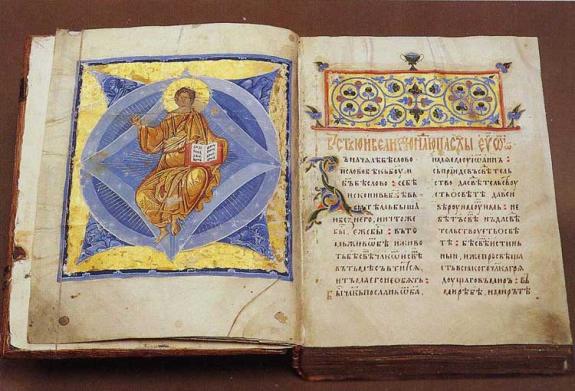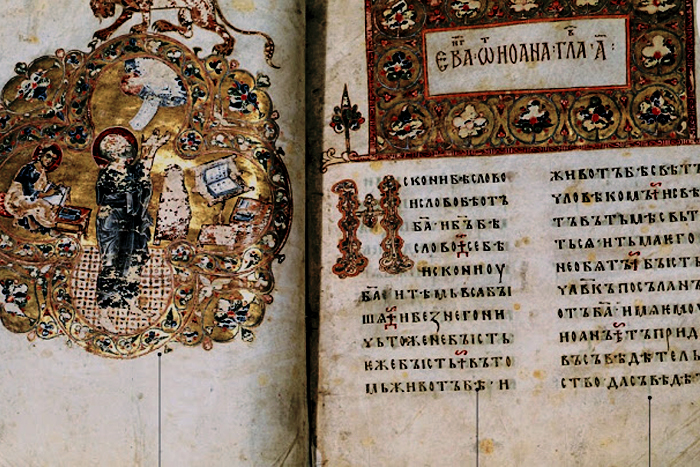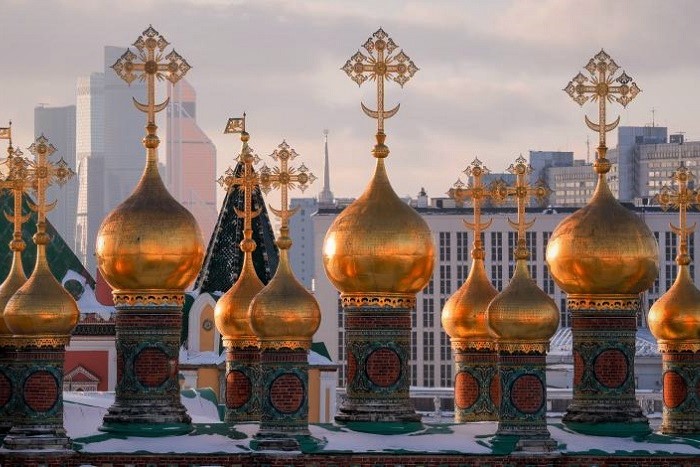 We can, however, only express the Truth if we foresee the extreme expression of all the contradictions inherent in it, from which it follows that Truth itself encompasses the ultimate projection of all its invalidations, is antonymic and cannot be otherwise.
We can, however, only express the Truth if we foresee the extreme expression of all the contradictions inherent in it, from which it follows that Truth itself encompasses the ultimate projection of all its invalidations, is antonymic and cannot be otherwise.
Pavel Florensky
***
I wrote in a previous article about the importance of contradictions in the knowledge of God. The Orthodox faith utterly delights in paradox and contradiction and liberally salts its language of worship with shockingly antonymic expressions. This is intentional and inherent to the nature of the kind of knowledge (koinonia) that alone is saving knowledge. Remembering this is important when we come to the study of the Scriptures. Doubtless, the most devastating practice with regard to the Scriptures is ridding them of contradiction. Today, this is done regularly, and from a number of directions. Apparently, human beings dislike contradiction and have a passion-driven instinct to minimize it. This diminution of reason goes by many names – some of them being so bold as to claim that this is reason itself. It is not. True reason is at home with contradiction.
The gospel proclamation of Christ is summarized by St. Paul in his First Letter to the Corinthians:
For I delivered [literally “traditioned” – it is a technical term in Greek] to you first of all that which I also received [“received” by “tradition”]:
that Christ died for our sins according to the Scriptures, and that He was buried, and that He rose again the third day according to the Scriptures, and that He was seen by Cephas, then by the twelve.
After that He was seen by over five hundred brethren at once, of whom the greater part remain to the present, but some have fallen asleep.
After that He was seen by James, then by all the apostles.
Then last of all He was seen by me also, as by one born out of due time. (1Co 15:3-8)
If the opening lines of this passage remind you of the Creed, it is because they most likely come from the most primitive Baptismal Creed, one version of which was later known as the Apostles’ Creed. This is not an off-hand narrative that St. Paul is making up as he writes. He is quoting, and specifically quoting a “tradition.”
At the heart of that tradition of the risen Christ is that He “died for our sins according to the Scriptures,” and that He “rose again the third day according to the Scriptures.” This does not mean “because the Scriptures said he did.” Rather it means, that His death for our sins and His resurrection on the third day are in accordance with the right reading of the Old Testament Scriptures. Indeed, we could say that the primitive Church proclaimed a message about the Old Testament itself that was as important (and new) as the news of Christ’s death and resurrection. Their radical proclamation was that all of the writings of the Old Testament were about the death and resurrection of Christ!
As I noted previously, this is simply not obvious on any reading of the Old Testament – unless you have been previously taught how to see it, look for it, and understand it, and have the ascetical discipline that allows the heart to “see.” This “according to the Scriptures” is itself part of that which is handed down. It is traditioned to us.
The treatment of the Scriptures, particularly since the Reformation, have ceased to acknowledge this dynamic, sometimes even being embarrassed by the unvarnished allegorical readings of the Fathers. The Reformation mantra that the Scriptures were the book for everyman, that each person, enlightened and guided by the Spirit, was capable of reading and understanding the Scriptures has consistently tended to privilege rationalistic schemes of interpretation. Alexander Campbell, one of the founders of the Protestant Restoration Movement, is said to have carried a Bible and the writings of John Locke. The “common sense” of Scottish rationalism has deeply affected the popular treatment of the Scriptures in the contemporary world.
There seems to be a general sense that the New Testament, however it arrived at its conclusions, is now the rational guide for reading the Old Testament. The Apostolic Church wrote by a miracle and we read with our reason. There is a rational paradigm that has risen in this context. It is rooted in the notion ofthe “authority” of Scripture (and its infallibility). How do I know that Christ is the truth? Because it’s in the Bible. How do I know that the Bible is true? Well, it says so in this verse here. That circular reasoning is actually as nonsensical as it sounds.
This also creates an anxiety of reliability. Every questioning of historical accuracy, every example of internal contradiction is met with rational explanations of how the Scriptures must be true. Extreme examples are those who insist on “Young Earth Creationism,” even suggesting that God created a universe that appeared old, but really isn’t. In Orthodox circles, this same approach is defended by citing any treatment within a Church Father that supports a literalist understanding. I have seen Fr. Thomas Hopko, of blessed memory, decried as a heretic because he suggested that Adam may not be a historical figure! There is some version of a “house of cards” in all of this. If this isn’t literally true, if this isn’t utterly reliable on a rational level, then that may not be true, nor this, nor…until faith itself collapses.

This is the tragic state of faith among many Christians, a foundation without merit, vulnerably standing on the playing field of modern rationalism. I personally believe it is the breeding ground of atheism…because it is a false position.
St. Luke has this:
Then He said to them, “These are the words which I spoke to you while I was still with you, that all things must be fulfilled which were written in the Law of Moses and the Prophets and the Psalms concerning Me.” And He opened their understanding, that they might comprehend the Scriptures. Then He said to them, “Thus it is written, and thus it was necessary for the Christ to suffer and to rise from the dead the third day, and that repentance and remission of sins should be preached in His name to all nations, beginning at Jerusalem.” (Luk 24:44-47)
This passage needs some care. In the Greek, it does not say “He opened their understanding.” Rather, it says, “He opened their nous.” The Scriptures are noetically understood. The nous and the heart are synonymous in many of the Fathers. It is by no means a synonym for discursive reason. Christ spiritually changed the disciples, such that they could see things that before had been hidden. And this change is directly associated with the encounter of the risen Lord. Christ nowhere opens the understanding of the disciples until after the resurrection. That noetic miracle is itself part of the resurrection. To be a witness of the resurrection includes the noetic understanding of the Scriptures.
And it is at this point that I direct us to the inherent contradictions within the text. I say “contradictions,” but I include within that the very “hiddenness” of the meaning. That meaning, if you will, is a “contradiction” of the letter. If the letter says, “Ark of the Covenant,” but we understand that it refers to the Theotokos (to use but one common example), then, there is a seeming contradiction between the letter and the meaning. If the text says, “lamb,” be we read “Christ,” there is an apparent contradiction between the letter and the meaning.
But the Fathers (including the Apostles) were not daunted by these seeming contradictions. There is a seeming contradiction in Christ Himself. He is a man, and appears as a man in every outward manner. But we confess Him as God, despite His death on the Cross. How can God die? His mother is a virgin, and yet she gave birth.
When we no longer see the contradiction in these things, the nous is darkened, and we begin to make of these great mysteries mere intellectual ciphers, rational objects to be manipulated in arguments, systematized and refined. True noetic perception involves great ascetic effort, in which we fast, pray and repent for the hardness of our hearts and our constant efforts to substitute an understanding that does not at every moment depend upon God.
There is a sense in which I revel in the contradictions (at least the ones I see). They are gateways into the Kingdom of God. I frequently encounter, however, an “easy” Orthodoxy, or “easy” Protestantism, etc., in which paradox and contradiction are deeply muted, explained, or simply avoided.
At every Divine Liturgy, I stand at the altar, and speak the contradiction, “And make this bread to be the precious Body of our Lord and God and Savior Jesus Christ…” Its opacity is a measure of my own heart. On those occasions in which things seem less than opaque, I do not know how to explain what I see. These are the moments of faith, a “participatory adherence to the Presence” in the words of Vladimir Lossky. And though I can proclaim, “Behold the Lamb of God who takes away the sin of the world,” I cannot demonstrate it as an object. I can love it and eat it and become one with it.
The reading of Scripture should resemble this far more than we realize. For Christ is there, within every word, every space between the words, and even in the silence that frames them.
“Didn’t our hearts burn within us!”
 We can, however, only express the Truth if we foresee the extreme expression of all the contradictions inherent in it, from which it follows that Truth itself encompasses the ultimate projection of all its invalidations, is antonymic and cannot be otherwise.
We can, however, only express the Truth if we foresee the extreme expression of all the contradictions inherent in it, from which it follows that Truth itself encompasses the ultimate projection of all its invalidations, is antonymic and cannot be otherwise.
 This is the tragic state of faith among many Christians, a foundation without merit, vulnerably standing on the playing field of modern rationalism. I personally believe it is the breeding ground of atheism…because it is a false position.
This is the tragic state of faith among many Christians, a foundation without merit, vulnerably standing on the playing field of modern rationalism. I personally believe it is the breeding ground of atheism…because it is a false position.




